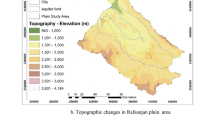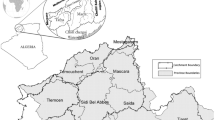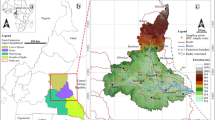Abstract
Assessing the water quality status for special use is the main objective of any water quality monitoring studies. The water quality index (WQI) is a mathematical instrument used to transform large quantities of water quality data into a single number which represents the water quality level. In fact, developing WQI in an area is a fundamental process in the planning of land use and water resources management. In this study, a simple methodology based on multivariate analysis is developed to create a groundwater quality index (GWQI), with the aim of identifying places with best quality for drinking within the Qazvin province, west central of Iran. The methodology is based on the definition of GWQI using average value of eight cation and anion parameters for 163 wells during a 3-year period. The proportion of observed concentrations to the maximum allowable concentration is calculated as normalized value of each parameter in observing wells. Final indices for each well are calculated considering weight of each parameter. In order to assess the groundwater quality of study area, the derived indices are compared with those of well-known mineral waters. Using developed indices, groundwater iso-index map for study area and the map of areas of which the indices are near to mineral waters was drawn. In the case study, the GWQI map reveals that groundwater quality in two areas is extremely near to mineral water quality. Created index map provides a comprehensive picture of easily interpretable for regional decision makers for better planning and management.
Similar content being viewed by others
References
Backman, B., Bodis, D., Lahermo, P., Rapant, S., & Tarvainen, T. (1998). Application of a groundwater contamination index in Finland and Slovakia. Environmental Geology, 36(1–2), 55–64. doi:10.1007/s002540050320.
Brown, R. M., McClelland, N. I., Deininger, R. A., & Tozer, R. G. (1970). A water quality index: Do we dare? Water & Sewage Works, 117, 339–343.
Couillard, D., & Lefebvre, Y. (1985). Analysis of water quality indices. Journal of Environmental Management, 21, 161–179.
Coulibaly, H., & Rodriguez, M. J. (2004). Development of performance indicators for Quebec small water utilities. Journal of Environmental Management, 73(3), 243–255. doi:10.1016/j.jenvman.2004.07.003.
Dalkey, N. C. D. (1968). An objective water quality index, The Rand Corporation Harkins. Journal - Water Pollution Control Federation, 46, 588–591.
Harkins, R. D. (1974). An objective water quality index. Journal–Water Pollution Control Federation, 46, 588–591.
Horton, R. K. (1965). An index number system for rating water quality. Journal–Water Pollution Control Federation, 37, 300–305.
House, M. A., & Ellis, J. B. (1987). The development of water quality indices for operational management. Journal of the Water Science and Technology, 19(9), 145–154.
Inhaber, M. (1975). An approach to a water quality index for Canada. Water Resources, 9, 821–833.
Liebman, H. (1969). Atlas of water quality methods and practical conditions. Munich: R. Oldenburg.
Melloul, A. J., & Collin, M. (1998). A proposed index for aquifer water-quality assessment: The case of Israel’s Sharon region. Journal of Environmental Management, 54(2), 131–142. doi:10.1006/jema.1998.0219.
O’Connor, M. F. (1972). The application of multi attributive scaling procedures of indices of value. Ann Arbor: Engineering Psychology Laboratory of the University of Michigan.
Prati, L., Pavanello, R., & Pesarin, F. (1971). Assessment of surface water quality by a single index of pollution. Water Resources, 5, 741–751.
Provencher, M., & Lamontagne, J. (1979). A method for establishing a water quality index for different uses. Quebec: Gouvernment du Quea’ bec, Ministea’ re des richesses naturelles, le Service de la qualitea’ des eaux, Bibliotequea’ nationale du Quea’ bec.
Ribeiro, L., Paralta, E., Nascimento, J., Amaro, S., Oliveira, E., & Salgueiro, R. (2002). A agricultura e a delimitac ao das zonas vulnera’veis aos nitratosdeorigem agrı’cola segundo a Directiva 91/676/CE. In: Proc. III Congreso Ibe’rico sobre Gestio’n e Planificacio’n del Agua (pp. 508–513). Universidad de Sevilla, Spain.
Saeedi, M. (2005). Site Selection for land filling hazardous waste in Shahid Rajaee power plant. Tehran: Iran University of Science and Technology (IUST), Research Report.
Saeedi, M., & Amini, H. R. (2007). Chemical, physical, mineralogical, morphology and leaching characteristics of a thermal power plant air heater washing Waste. International Journal of Environmental Research, 1(1), 74–79.
Scottish Development Department (1975). Towards cleaner water. Edinburgh: HMSO, Report of a River Pollution Survey of Scotland.
Shaefer, D. J., & Janardan, K. G. (1977). Communicating environmental information to the public a new water quality index. The Journal of Environmental Education, 8, 18–26.
Soltan, M. E. (1999). Evaluation of groundwater quality in Dakhla Oasis (Egyptian Western Desert). Environmental Monitoring and Assessment, 57(2), 157–168. doi:10.1023/A:1005948930316.
S’tambuk-Giljanovic, N. (1999). Water quality evaluation by index in Dalmatia. Water Resources, 33(16), 2440–3423.
Stigter, T. Y., Ribeiro, L., & Carvalho Dill, A. M. M. (2006a). Application of a groundwater quality index as an assessment and communication tool in agro-environmental policies–Two Portuguese case studies. Journal of Hydrology (Amsterdam), 327, 578–591. doi:10.1016/j.jhydrol.2005.12.001.
Stigter, T. Y., Ribeiro, L., & Carvalho Dill, A. M. M. (2006b). Evaluation of an intrinsic and a specific vulnerability assessment method in comparison with groundwater salinisation and nitrate contamination levels in two agricultural regions in the south of Portugal. Journal of Hydrogeology, 14(1–2), 79–99. doi:10.1007/s10040-004-0396-3.
TAMAB (Iran Water Resources Research Center) (2006). Ground water status in Qazvin platue-2002–2005. Tehran: Iran Water Resources Research Center, Report.
Walski, T. M., & Parker, F. L. (1974). Consumers water quality index. Journal of the Environmental Engineering Division, 100, 259–611.
Yagow, E. R. (1997). Auxiliary procedures for the AGNPS model in urban fringe watersheds. Ph.D. thesis, Virginia Polytechnic Institute and State University, Blacksburg, VA, USA, 140.
Author information
Authors and Affiliations
Corresponding author
Rights and permissions
About this article
Cite this article
Saeedi, M., Abessi, O., Sharifi, F. et al. Development of groundwater quality index. Environ Monit Assess 163, 327–335 (2010). https://doi.org/10.1007/s10661-009-0837-5
Received:
Accepted:
Published:
Issue Date:
DOI: https://doi.org/10.1007/s10661-009-0837-5




